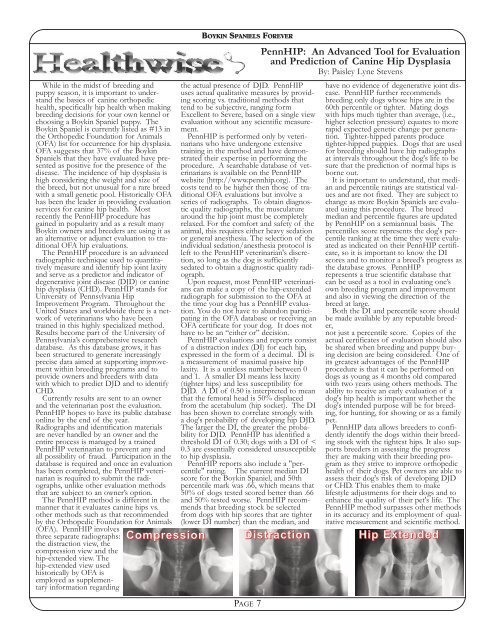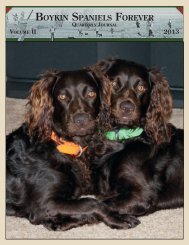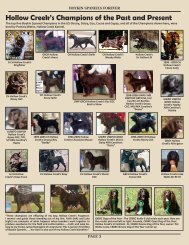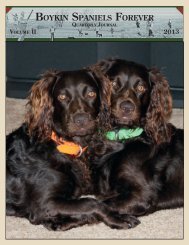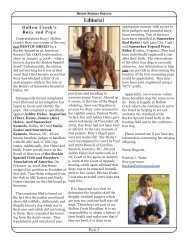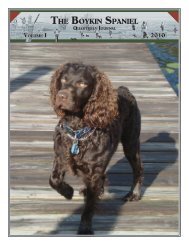Volume IV - Hollow Creek Kennel
Volume IV - Hollow Creek Kennel
Volume IV - Hollow Creek Kennel
- No tags were found...
You also want an ePaper? Increase the reach of your titles
YUMPU automatically turns print PDFs into web optimized ePapers that Google loves.
While in the midst of breeding andpuppy season, it is important to understandthe basics of canine orthopedichealth, specifically hip health when makingbreeding decisions for your own kennel orchoosing a Boykin Spaniel puppy. TheBoykin Spaniel is currently listed as #13 inthe Orthopedic Foundation for Animals(OFA) list for occurrence for hip dysplasia.OFA suggests that 37% of the BoykinSpaniels that they have evaluated have presentedas positive for the presence of thedisease. The incidence of hip dysplasia ishigh considering the weight and size ofthe breed, but not unusual for a rare breedwith a small genetic pool. Historically OFAhas been the leader in providing evaluationservices for canine hip health. Mostrecently the PennHIP procedure hasgained in popularity and as a result manyBoykin owners and breeders are using it asan alternative or adjunct evaluation to traditionalOFA hip evaluations.The PennHIP procedure is an advancedradiographic technique used to quantitativelymeasure and identify hip joint laxityand serve as a predictor and indicator ofdegenerative joint disease (DJD) or caninehip dysplasia (CHD). PennHIP stands forUniversity of Pennsylvania HipImprovement Program. Throughout theUnited States and worldwide there is a networkof veterinarians who have beentrained in this highly specialized method.Results become part of the University ofPennsylvania’s comprehensive researchdatabase. As this database grows, it hasbeen structured to generate increasinglyprecise data aimed at supporting improvementwithin breeding programs and toprovide owners and breeders with datawith which to predict DJD and to identifyCHD.Currently results are sent to an ownerand the veterinarian post the evaluation.PennHIP hopes to have its public databaseonline by the end of the year.Radiographs and identification materialsare never handled by an owner and theentire process is managed by a trainedPennHIP veterinarian to prevent any andall possibility of fraud. Participation in thedatabase is required and once an evaluationhas been completed, the PennHIP veterinarianis required to submit the radiographs,unlike other evaluation methodsthat are subject to an owner’s option.The PennHIP method is different in themanner that it evaluates canine hips vs.other methods such as that recommendedby the Orthopedic Foundation for Animals(OFA). PennHIP involvesthree separate radiographs:the distraction view, thecompression view and thehip-extended view. Thehip-extended view usedhistorically by OFA isemployed as supplementaryinformation regardingBOYKIN SPANIELS FOREVERthe actual presence of DJD. PennHIPuses actual qualitative measures by providingscoring vs. traditional methods thattend to be subjective, ranging formExcellent to Severe, based on a single viewevaluation without any scientific measurement.PennHIP is performed only by veterinarianswho have undergone extensivetraining in the method and have demonstratedtheir expertise in performing theprocedure. A searchable database of veterinariansis available on the PennHIPwebsite (http://www.pennhip.org). Thecosts tend to be higher then those of traditionalOFA evaluations but involve aseries of radiographs. To obtain diagnosticquality radiographs, the musculaturearound the hip joint must be completelyrelaxed. For the comfort and safety of theanimal, this requires either heavy sedationor general anesthesia. The selection of theindividual sedation/anesthesia protocol isleft to the PennHIP veterinarian's discretion,so long as the dog is sufficientlysedated to obtain a diagnostic quality radiograph.Upon request, most PennHIP veterinarianscan make a copy of the hip-extendedradiograph for submission to the OFA atthe time your dog has a PennHIP evaluation.You do not have to abandon participatingin the OFA database or receiving anOFA certificate for your dog. It does nothave to be an “either or” decision.PennHIP evaluations and reports consistof a distraction index (DI) for each hip,expressed in the form of a decimal. DI isa measurement of maximal passive hiplaxity. It is a unitless number between 0and 1. A smaller DI means less laxity(tighter hips) and less susceptibility forDJD. A DI of 0.50 is interpreted to meanthat the femoral head is 50% displacedfrom the acetabulum (hip socket). The DIhas been shown to correlate strongly witha dog's probability of developing hip DJD.The larger the DI, the greater the probabilityfor DJD. PennHIP has identified athreshold DI of 0.30; dogs with a DI of


